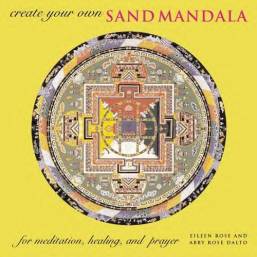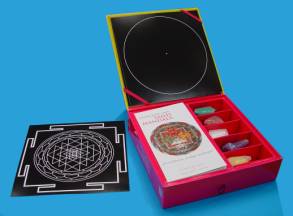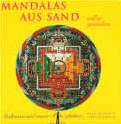Create Your Own Sand Mandala
Create Your Own Sand Mandala:
For Meditation, Healing, and Prayer

By Eileen M. Rose and Abby Rose Dalto
ISBN#1841812056
Godsfield Press Ltd. (UK) / Released by Red Wheel/Weiser (US)
Summary
 Constructing a sand mandala is an ancient Tibetan ritual art. A mandala (Sanskrit for “circle”) is a sacred, symbolic diagram, used as a meditational aid in Buddhism and Hinduism. One of the most interesting aspects of Tibetan sand mandalas is that the diagram is meant to be impermanent. Although many hours of painstaking skill go into its construction, after being used in a sacred ceremony, a sand mandala is swept up and the sand scattered into a nearby river or lake as a blessing. Many people find the dismantling and scattering of the sand to be the most moving part of the ritual.
Constructing a sand mandala is an ancient Tibetan ritual art. A mandala (Sanskrit for “circle”) is a sacred, symbolic diagram, used as a meditational aid in Buddhism and Hinduism. One of the most interesting aspects of Tibetan sand mandalas is that the diagram is meant to be impermanent. Although many hours of painstaking skill go into its construction, after being used in a sacred ceremony, a sand mandala is swept up and the sand scattered into a nearby river or lake as a blessing. Many people find the dismantling and scattering of the sand to be the most moving part of the ritual.
Create Your Own Sand Mandala will appeal to anyone interested in meditation, Buddhism, or sacred art. This kit makes it possible for anyone of any level of artistic ability to design his or her own personalized sand mandala ceremony. It contains enough sand to make three mandalas in five sacred colors (red, yellow, green, blue, and white), a funnel for directing the flow of the sand, and a brush for sweeping it up. The kit’s box opens to become a base on which the mandala can be created and the kit also includes templates for guiding your designs. Instruction for coloring your own sand is provided for those who wish to make additional sand mandalas.
The accompanying full-color book gives a brief history of the use and significance of sand mandalas in Tibetan Buddhism, as well as various examples of mandalas, sand paintings, and “sacred circles” in other cultures. Readers will learn how mandalas can be used as aids to meditation, as a form of prayer, in psychology, and in healing ceremonies. Readers will also learn some of the traditional meanings of colors and symbols used in mandalas, as well as meditation techniques for centering and setting the intention for a mandala.
Easy to follow step-by-step instructions guide readers in creating mandalas for healing, personal empowerment, and as an aid to prayer for peace. Readers interested in creating mandalas in materials other than sand will find guidelines for using paint, pencil, computer software, natural materials, and other mediums, as well as full color examples of “mandala” artwork by contemporary artists. (Learn more about the mandala.)
Authors
Eileen M. Rose
Abby Rose Dalto
Contents
Introduction: What a Sand Mandala is and Why You’ll Want to Create One
Chapter 1: The Mandala in World Traditions
Chapter 2: Color and Traditional Symbolism
Chapter 3: Creating Your Own Sand Mandala
Chapter 4: Creating a Healing Mandala
Chapter 5: Creating a Mandala for Personal Empowerment
Chapter 6: Creating a Mandala for Peace
Chapter 7: More Ways of Bringing the Mandala into Your Life
Chapter 8: Mandalas in Paint, Pencil, Pixel, and Stone
Appendix: How to Color Your Own Sand
Resources for Further Study
Other Editions



Send us your letters and pictures.
We would love to hear from our readers. Let us know about your own experiences, miracles, insights, and healings that you may have reached through the mandala. Photographs and drawings are also welcomed. Contact Us
The Gyuto Tantric University
We would like to thank the Gyuto Tantric University. This book would not have been possible without the cooperation of monks from the Gyuto monastery, therefore we have donated a portion of our proceeds to them.
The Gyuto Tantric University is one of the most outstanding monasteries of Tibet and it is the place for studying Buddhist philosophy, Tantric meditations, and ritual arts. The Gyuto monastery and the monks are well known in Tibet and were always admired by the Tibetan community, because of their services to their people. Traditional Tibetan tantric monks are believed to be healers through their ritual performance activities. One of the main disciples of Lama Tsongkhapa, Jetsun Kunga Dhondup, founded the Gyuto monastery in 1474 in Eastern Tibet.
Between 1474 and 1959, the Gyuto monks made their home in Lhasa’s Ramoche Temple. In 1959, the Ramoche Temple was severely damaged by Chinese communists and their sympathizers following their violent occupation of Tibet. The Gyuto monks and many Tibetans had to flee to India, where the Gyuto monastery was reestablished. Despite many difficulties in the new settlement they still managed to practice and educate over 400 monks, mostly young refugees from Tibet. The Gyuto monastery is currently located in Sidhbari, near Dharmasala (the home of his Holiness the Dalai Lama).
There are many ways to support Gyuto monks and their monastery, in order to share their rare tantric rituals and their experiences. You can sponsor a monk resident at the Gyuto Vajrayana Center in San Jose, or one in India, by making a donation. Your donation helps to cover expenses such as house rent, medical bills, food, transportation, utility bills, monks’ robes, and other minor expenses. Even a small donation is of great benefit. There are 400 monks at the Gyuto monastery in India, mainly young refugees. Besides educating, clothing, and feeding these monks, Gyuto monastery would like to build a Medicine Buddha clinic near the Dharamsala site, to provide medical care to the entire Tibetan and Indian local community.
If you are interested in sponsoring a monk or making a donation, please contact Venerable Thupten Donyo at the Center at (408) 926-9430 or email to info@gyutocenter.org, and he will be more than happy to give you more information about the monastery, or the monks.
The Gyuto Vajrayana Center is a non-profit organization [501(c)3] and all donations are tax-deductible.